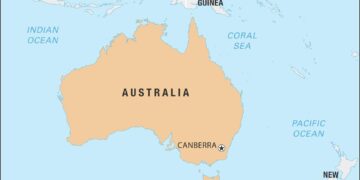The Metropolitan Museum of Art has unveiled its newly reimagined Arts of Oceania galleries, offering visitors a fresh and immersive experience into the diverse artistic traditions of the Pacific Islands. This significant renovation highlights an expanded collection of works from across Oceania, including Indigenous art from Papua New Guinea, Polynesia, Micronesia, and Melanesia. Through innovative displays and contextual storytelling, The Met invites the public to explore the rich cultural heritage and contemporary creativity of Pacific communities, reinforcing its commitment to broadening representation within its galleries. The reopening marks a pivotal moment in the museum’s ongoing efforts to celebrate and preserve Oceanic art on an international stage.
Metropolitan Museum Unveils Expansive Arts of Oceania Galleries Highlighting Diverse Pacific Cultures
The Metropolitan Museum has launched a striking transformation of its Arts of Oceania galleries, presenting a vivid and comprehensive exploration of Pacific Island cultures. This renewed exhibit features an expansive collection of artifacts, textiles, and ritual objects that illuminate the artistic ingenuity and deep spiritual traditions spanning regions such as Polynesia, Melanesia, and Micronesia. Visitors are invited to experience the profound narratives behind each piece, with expertly curated displays that emphasize the interconnectedness and diversity of these islands’ visual languages.
Highlights of the galleries include:
- Rarely exhibited tapa cloths decorated with intricate geometric patterns
- Carved wooden figures symbolizing ancestral spirits and deities
- Vibrant featherwork and ceremonial regalia from Fiji and Hawaii
- Interactive maps tracing the migration and trade routes of Pacific peoples
| Region | Key Art Forms | Notable Materials |
|---|---|---|
| Polynesia | Wood carving, Tattooing tools | Ironwood, Bone |
| Melanesia | Mask making, Ceremonial objects | Shell, Pigments |
| Micronesia | Textiles, Navigation charts | Bark cloth, Coconut fiber |
Innovative Curation and Contemporary Perspectives Bring New Life to Traditional Oceanic Artworks
The revitalized Arts of Oceania galleries at The Met mark a transformative moment in museum curation, blending cutting-edge exhibition techniques with profound respect for Pacific Islander traditions. By integrating multimedia installations, interactive displays, and thoughtfully curated narratives, the galleries invite visitors to experience Oceanic cultures through fresh lenses. This approach not only highlights the intricate craftsmanship of traditional objects but also emphasizes their ongoing cultural significance and the voices of contemporary Pacific artists. Such a dynamic presentation dismantles the static perception of museum artifacts, positioning them instead as living cultural expressions with stories that resonate today.
A key element of the galleries’ innovation is their collaborative framework, which includes partnerships with Pacific communities, scholars, and artists. These collaborations provide authenticity and depth, enriching the visitor experience and fostering cross-cultural dialogue. Featured collections include:
- Mäori woven textiles that demonstrate ancient techniques revitalized by modern artisans
- Contemporary Papua New Guinean sculptures blending traditional symbolism with experimental forms
- Interactive digital maps tracing migration patterns and the cultural exchanges spanning the Pacific
This inclusive and innovative curation breathes new life into traditional Oceanic artworks, inviting audiences to appreciate them not only as historical artifacts but as vibrant contributors to ongoing cultural conversations.
| Gallery Feature | Description |
|---|---|
| Immersive Soundscapes | Ambient Pacific Island sounds accompany select displays |
| Artist Spotlights | Profiles and works of emerging Oceanic contemporary artists |
| Community Storytelling | Oral histories and video narratives from island elders |
Visitor Guide to Experiencing the Met’s Oceania Galleries with Expert Recommendations
Stepping into the reimagined Arts of Oceania galleries at The Met is an immersive journey into the rich cultural tapestry of the Pacific Islands. Visitors can expect to encounter a diverse array of artworks, from intricate tapa cloths to imposing carved figures, each telling stories of ancient traditions and contemporary creativity. Experts recommend beginning your visit with the interactive digital stations strategically placed throughout the galleries, which offer deep dives into the symbolism behind key objects. Don’t miss the stunning display of masks and ceremonial objects from Papua New Guinea, where detailed craftsmanship and vibrant colors highlight the spiritual and social significance embedded in these creations.
To enhance your experience, keep an eye out for special curator-led tours and timed talks, often announced on The Met’s events calendar. These sessions illuminate less visible narratives, like the connections between art forms across different island cultures and the impact of colonial histories. Additional tips for visitors include:
- Allocate at least 90 minutes to fully appreciate each section without rushing.
- Use the gallery’s downloadable map and audio guide for a self-paced, informative experience.
- Visit the adjacent Oceanic-inspired installation space, which offers contemporary takes by Pacific artists.
| Gallery Section | Highlight | Recommended Viewing Time |
|---|---|---|
| Polynesian Art | Feathered Capes & Navigation Tools | 20 minutes |
| Melanesian Ritual Objects | Carved Ancestral Figures | 25 minutes |
| Micronesian Textiles | Intricate Weavings & Tattoos | 15 minutes |
| Contemporary Pacific Art | Mixed Media and Installations | 30 minutes |
In Retrospect
The reopening of The Met’s Arts of Oceania galleries marks a significant moment in the museum’s ongoing commitment to presenting diverse cultural narratives with respect and depth. By showcasing works from the Pacific through a reimagined lens, The Met not only honors the rich artistic traditions of Oceania but also invites visitors to engage with these cultures in new and meaningful ways. As the galleries welcome the public, they stand as a testament to the importance of inclusive storytelling in the world of art and museums.














